Great news for Apple iPhone owners looking for their first taste of Virtual Reality, who may have been forgiven lately for some element of jealousy towards their Samsung toting counterparts.
The Zeiss VR One is the first ‘slip in’ mobile VR headset from a major manufacturer that is compatible with the iPhone, and follows hot on the heels of Samsung’s Gear VR, which turns a Galaxy Note 4 phone into a full featured mobile VR headset.
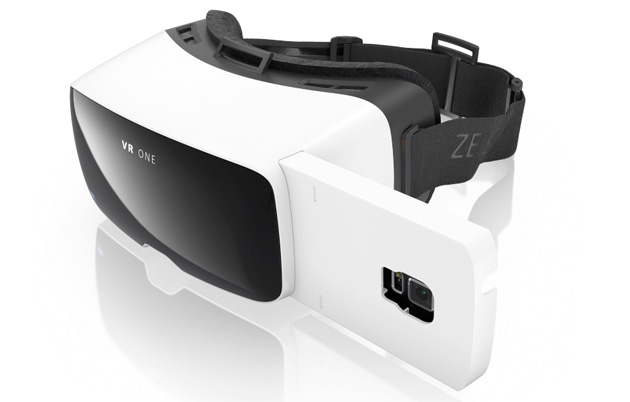
The Samsung Gear VR was the first slide-in, phone-based VR headset (aka smartphone adapter) from a major manufacturer, that uses a smart phone as the electronic guts and screen of the device. I was tempted to buy a Note 4, just to get at the Samsung Gear VR, as the prospect of ‘wires-free’ virtual reality was immense. One of the problems with the Oculus Rift has been the bird’s nest of wires and connections to make it work.
Mobile VR headsets have no such problem, you slip the phone in and that’s it. They also have the not insignificant benefit of being much much cheaper – they don’t need any electronics (at all), and are basically just a (dumb) case and two lenses.
This works because a modern smart phone has everything you need for a contemporary VR headset – high resolution screen, powerful computer, motion sensors, battery, online connectivity, all wrapped up in the tiniest package possible.
Indeed, even Oculus use a mobile phone screen from Samsung in their Rift VR headset – the two companies are in partnership.

Until now though, there was no such device for Apple iPhone owners, at least from a major company. Google’s cheap and cheerful Cardboard VR project is ostensibly aimed at Android devices (although people have made it work with the iPhone), and an array of Kickstarter projects have sprung up to fill the gap.
Enter German company Carl Zeiss AG, who have stepped into the fray in a major move, with the release of the Zeiss VR One – an extremely attractive, and very reasonably priced (at $99), ‘slip in’ mobile VR headset.
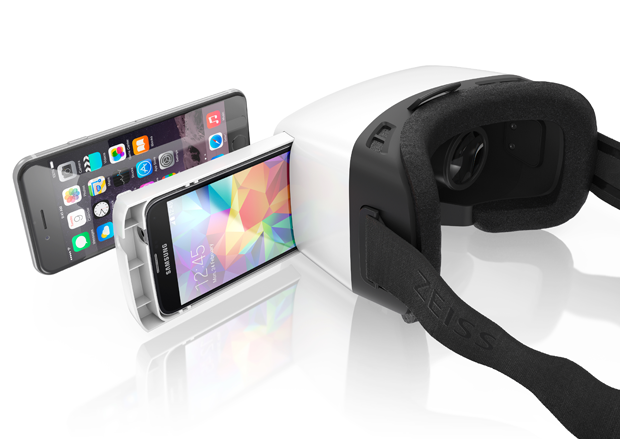
Photographers will recognize the Zeiss name immediately. Carl Zeiss make the best lenses in the world, and have been doing so since their eponymous founder began making microscopes in 1846. They are a very high end glass/optical company, which it turns out makes them the ideal candidate to make great mobile VR goggles.
As some users of the Oculus Rift discovered, Oculus shipped inferior plastic lenses for the DK2, compared to the glass lenses of the DK1, and quality suffered. The lenses were so bad in places (towards the edges) that Oculus tried to fix these ‘chromatic aberrations’ in software, by remapping the R, G and B components of pixels. These are visible for example in Elite Dangerous, where white ‘stars’ split into red, green and blue. Supposedly some DK2 owners even retrofitted their headsets with lenses from the original Rift to improve matters, although I’ve not been able to confirm this.
The bottom line is that if you have a screen 1 inch from your eyeballs, you want ‘good glass’ between you and the screen. Photographers know this, opticians know this, and we should know this. Serious and possibly harmful eye fatigue is a real issue with VR, and bad lenses are a primary cause.
With Carl Zeiss bringing their considerable talents to the problem, I was keen to experience the Zeiss VR One myself…
Review of the Zeiss VR One
Out of the box you know you have a high quality product in the VR One. The headset is well packaged, beautifully designed, and the white appearance with smoked front, makes a refreshing change from the all-black, ‘gamer’ Rift. The VR One looks and feels stylish, and is something you’d be proud to display on your coffee table. It would certainly gain attention, and with no wires… it’s truly grab-and-play.

Getting started on the VR One is as simple as slipping your phone into a white plastic tray (sold alongside the device) that is specific to your phone. Currently there are trays for the iPhone 6 (regular size) or Samsung Galaxy S5. You download some VR apps and slide the tray (with your phone) into the headset.

VR headsets split the visual display into two images – left and right – and on the VR One these images are spherical and positioned so as to work best with the Zeiss lenses. Your regular iPhone screen obviously doesn’t display images this way, and this is why Zeiss (and other VR headset manufacturers) are commonly offering ‘VR Launcher’ apps, that allow you to launch VR apps using a 3D interface designed specifically for VR use. This means apps can be launched without having to take off the headset.
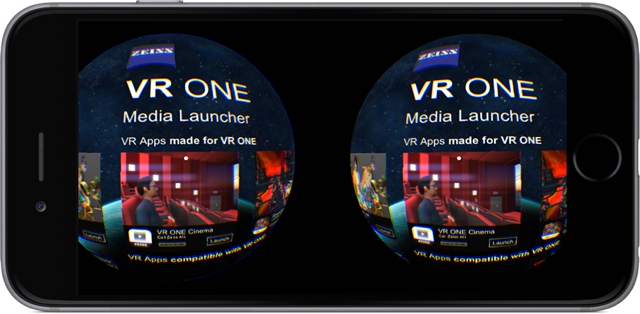
Zeiss offer the VR One Media Launcher, an app that uses a Kinect-style interface, where a tiny white dot (the cursor) sits in the middle of the screen, and can be positioned (by looking in the right direction) over a button for a few seconds – to activate the app. This works pretty well. The apps themselves need to be installed first (in the normal iPhone way) before you can launch them from the VR One Media Launcher.
I spent a few minutes browsing for compatible VR apps and installing them, before going back to wearing the headset and trying the media launcher to launch them. You don’t need to use the media launcher to launch VR apps. You can just open up a VR app on the phone, put it in the headset… and voilà. So far I seem to be doing it more this way to be honest.
The first VR app I got working besides the Media Launcher was VR One Cinema. This is another Zeiss app that puts you inside a rendered 3D cinema, where you can view 2D content on the (3D) screen in front of you. If you turn around in the cinema, you can see the theatre seats, a couple of other people watching the screen, etc. You use the ‘white dot’ method to bring up a menu.
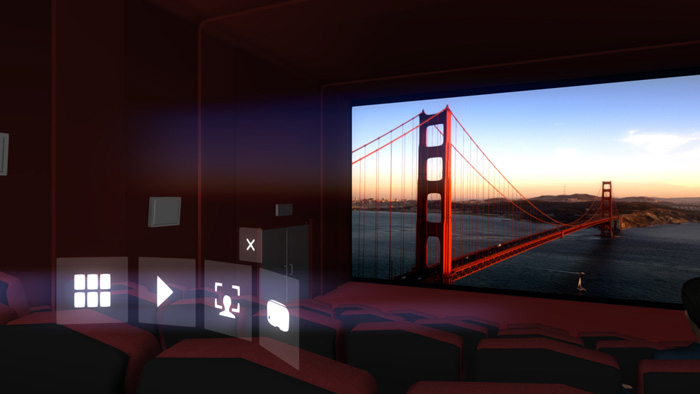
The menu gives you the option to load movies, or videos from the camera roll. It wasn’t immediately obvious to me that these were different things, and I was trying to launch camera roll videos from the movies option.
I finally pulled up some videos from the iPhone’s camera to test things out and it was fun… for a few minutes. Perhaps shaky iPhone videos are not ideal for viewing on a VR headset, and it was also immediately apparent that the resolution of the display was not as good as the Oculus Rift DK2 – which put me off somewhat.
A quick Google search and the technical reason becomes apparent… Here are the screen resolutions for various VR headsets below:
| VR Headset | Screen Resolution | Resolution Per Eye |
|---|---|---|
| Oculus Rift DK1 | 1280 x 800 | 640 x 800 |
| Zeiss VR One (iPhone 6) | 1334 x 750 | 667 x 750 (0.7k x 0.7k) |
| Oculus Rift Dk2 | 1920 x 1080 | 960 x 1080 (1k x 1k) |
| Zeiss VR One (Samsung S5) | 1920 x 1080 | 960 x 1080 (1k x 1k) |
| Samsung Gear VR (Samsung Note 4) | 2560 x 1440 | 1280 x 1440 (1.3k x 1.4k) |
The iPhone 6 (regular) display screen is 1334 x 750 pixels. The DK2 is 1920 x 1080. With the video playing on a simulated cinema screen on the VR One, i.e. not filling the whole viewable area, the resolution is reduced even further.
Watching movies in virtual VR cinemas is probably not what you want a VR headset for, not at least until the screens are at least double the resolution they are now. Remember that whatever resolution for the screen is used, it is immediately cut in half to cater for each eye. So a 4k x 2k pixel screen only yields 2k x 2k per eye, what I consider to be the tipping point for mainstream VR. For VR that is indistinguishable from reality, I believe 8k x 8k per eye is needed.
The VR One, when using the iPhone 6 offers roughly 0.7k x 0.7k eye, or with the Samsung S5 around 1k x 1k per eye – so its important to put this into perspective when evaluating quality. It’s better than the DK1, and on a par or ‘almost as good’ as the DK2, depending on your phone. This is no mean feat for a device that is 1/4 of the cost of the DK2, and the slight loss of resolution on an iPhone compared to the S5 shouldn’t put you off buying.
There aren’t many apps available yet, only a handful at the time of writing besides Zeiss’ own apps – that are specifically for the VR One. Zeiss offer an SDK for Unity, the most popular 3D game programming engine, so in theory it’s pretty simple to make a VR app, and more should hit the app store soon. You don’t have to restrict yourself to Zeiss VR One specific apps however – in theory you can enjoy any side-by-side VR or 3D content, but the reality is that it doesn’t work well if VR apps are not optimized for the headset being used.
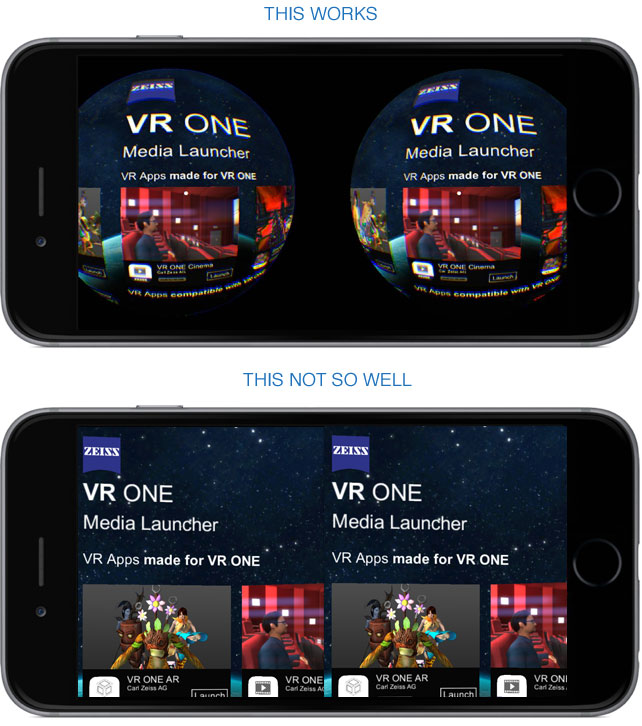
Different headsets use different lenses, so the optimal content position varies between headsets from different manufacturers. I expect apps will begin to offer different ‘views’ for the most popular headsets soon, as this should be relatively trivial to implement. It’s just a different ‘warp’ or view of something that is in a 3D program already.
The Bottom Line
The VR One is excellent, and I’m now a convert to smart phone VR headsets. I didn’t expect that happening.
Latency is much better than I anticipated – a virtual reality app on the iPhone works surprisingly well, and reacts quickly to the most subtle of movements in all directions. Latency on some apps seems to be hit and miss, some worse than others, but in general is pretty good.
I find myself wanting to play with the Zeiss VR One much more than the Oculus Rift (DK2). Sure the resolution is not as good, and this is something I’m generally sensitive to, yet the sheer convenience, speed of setup, and self-contained form factor make the difference. Setting up the Rift on a PC can take 5-20 minutes every time. There’s updates to download, issues to solve, plus all the connections and wires everywhere. A smart phone fires up right away and ‘just works’.
The next generation of smartphone screens within a year or two are going to be 4k, offering up 2k x 2k per eye for VR, and probably the same as Oculus’ forthcoming consumer version of the Rift (read my review on the Crescent Bay prototype here). Hopefully Apple will put a 4k screen in the iPhone 7 (and will offer their own VR device).
I would be surprised not to see phone manufacturers specifically catering to virtual reality headset adapters in their future devices. OLED screens (like those in the Samsung S3 and Note 4) are ideal for VR, and an obvious other improvement would be for phones to have twin cameras on their backs, to provide ‘see through’ video and much improved augmented reality. The cameras themselves could have fish-eye type lenses, to effectively replicate our human field of view.
At $99, the Zeiss VR One represents a bargain entry to the forthcoming VR revolution, and if Zeiss play nicely it could have upgrade potential if they support future iPhone models with new trays.
If I had an Android phone (and definitely if I had the Galaxy Note 4) I would go with the Samsung Gear VR for now, as you get a better screen and a larger ecosystem, but for iPhone owners and S5 owners the Zeiss VR One is your best option. It won’t be your last VR headset, but there’s a it probably should be your first.
